Fatigue Crack Growth Rate Description of RF-Plasma-Sprayed Refractory Metals and Alloys
Abstract
1. Introduction
2. Materials and Methods
2.1. Deposition
2.2. Fatigue Crack Growth Rate
2.3. Mechanical Properties Testing
2.4. Hartmann–Schijve Fit
2.5. Metallography
3. Results and Discussion
3.1. Microstructure
3.2. Fracture Properties
4. Conclusions
4.1. Deposits of Inherently Brittle Materials (Mo, W, and the Mo-20W Composite)
- Defects typical to plasma-sprayed materials such as intersplat interfaces and different types of porosity resulted in limited toughness values, from MPa·m to MPa·m.
- Fatigue crack growth thresholds from extremely low values of MPa·m up to MPa·m were observed, with highest values obtained for smaller particle size pretreated powders.
- The Mo and W deposits have very similar fatigue crack growth resistance at the threshold value of m·cycle at MPa·m. Another W deposit from a coarse powder had much lower MPa·m.
4.2. Tungsten Heavy Alloys
- Adding Ni to the W powder led to a fully developed WHA structure that significantly increased both and values. This increase is caused by elimination of most of the intersplat interface imperfections by liquid state diffusion processes that take place during the deposition and by forming a ductile Ni-based matrix binder phase.
- The saturated solid solution of W in Ni represents a ductile binder phase with a limited fatigue crack growth threshold value, as demonstrated through the W-65Ni deposit with very low MPa·m.
- The W particles from untreated powder in W-10Ni* deposits increase the threshold value significantly to MPa·m.
- The use of pre-treated W powders further improves the strength of the reinforcement W particles and this in turn increases the fracture toughness of the deposit by a factor of three.
Author Contributions
Funding
Institutional Review Board Statement
Informed Consent Statement
Data Availability Statement
Conflicts of Interest
Abbreviations
| FCGR | fatigue crack growth rate |
| SEM | scanning electron microscope |
| ECCI | electron channeling contrast imaging |
| H-S | Hartmann–Schijve |
| RF-ICP | radio frequency inductively coupled plasma |
References
- Gludovatz, B.; Wurster, S.; Hoffmann, A.; Pippan, R. Fracture toughness of polycrystalline tungsten alloys. Int. J. Refract. Met. Hard Mater. 2010, 28, 674–678. [Google Scholar] [CrossRef]
- Taguchi, K.; Nakadate, K.; Matsuo, S.; Tokunaga, K.; Kurishita, H. Fatigue pre-cracking and fracture toughness in polycrystalline tungsten and molybdenum. J. Nucl. Mater. 2018, 498, 445–457. [Google Scholar] [CrossRef]
- Tripathi, J.; Novakowski, T.; Joseph, G.; Linke, J.; Hassanein, A. Temperature dependent surface modification of molybdenum due to low energy He+ ion irradiation. J. Nucl. Mater. 2015, 464, 97–106. [Google Scholar] [CrossRef]
- Neu, R.; Maier, H.; Balden, M.; Elgeti, S.; Gietl, H.; Greuner, H.; Herrmann, A.; Houben, A.; Rohde, V.; Sieglin, B.; et al. Investigations on tungsten heavy alloys for use as plasma facing material. Fusion Eng. Des. 2017, 124, 450–454. [Google Scholar] [CrossRef]
- Cizek, J.; Kovarik, O.; Siska, F.; Bensch, J.; Cupera, J.; Matejkova, M.; Siegl, J.; Chraska, T.; Khor, K.A. Increasing fatigue endurance of hydroxyapatite and rutile plasma sprayed biocomponents by controlling deposition in-flight properties. ACS Biomater. Sci. Eng. 2019, 5, 1703–1714. [Google Scholar] [CrossRef] [PubMed]
- Heuer, S.; Matějíček, J.; Vilémová, M.; Koller, M.; Illkova, K.; Veverka, J.; Weber, T.; Pintsuk, G.; Coenen, J.W.; Linsmeier, C. Atmospheric plasma spraying of functionally graded steel/tungsten layers for the first wall of future fusion reactors. Surf. Coatings Technol. 2019, 366, 170–178. [Google Scholar] [CrossRef]
- Klecka, J.; Cizek, J.; Matejicek, J.; Lukac, F.; Vala, J. Thick functionally-graded W-316L composite coatings for nuclear fusion applications. Nucl. Mater. Energy 2023, 34, 101373. [Google Scholar] [CrossRef]
- Kovarik, O.; Haušild, P.; Siegl, J.; Chráska, T.; Matějíček, J.; Pala, Z.; Boulos, M. The influence of substrate temperature on properties of aps and vps w coatings. Surf. Coat. Technol. 2015, 268, 7–14. [Google Scholar] [CrossRef]
- Kovarik, O.; Materna, A.; Siegl, J.; Cizek, J.; Klecka, J. Fatigue crack growth in plasma-sprayed refractory materials. J. Therm. Spray Technol. 2019, 28, 87–97. [Google Scholar] [CrossRef]
- Matějíček, J.; Kavka, T.; Bertolissi, G.; Ctibor, P.; Vilémová, M.; Mušálek, R.; Nevrlá, B. The role of spraying parameters and inert gas shrouding in hybrid water-argon plasma spraying of tungsten and copper for nuclear fusion applications. J. Therm. Spray Technol. 2013, 22, 744–755. [Google Scholar] [CrossRef]
- Matějíček, J.; Vilémová, M.; Nevrlá, B.; Kocmanová, L.; Veverka, J.; Halasová, M.; Hadraba, H. The influence of substrate temperature and spraying distance on the properties of plasma sprayed tungsten and steel coatings deposited in a shrouding chamber. Surf. Coatings Technol. 2017, 318, 217–223. [Google Scholar] [CrossRef]
- Wang, Y.; Xiong, X.; Xie, L.; Xu, X.; Min, X.; Zheng, F. Sintering Behavior of Tungsten Heavy Alloy Products Made by Plasma Spray Forming. Mater. Trans. 2011, 52, 759–767. [Google Scholar] [CrossRef]
- Kovarik, O.; Čech, J.; Čapek, J.; Hajíček, M.; Klecka, J.; Siegl, J. Mechanical properties of forged tungsten heavy alloys. Acta. Polytech. CTU Proc. 2020, 27, 149–154. [Google Scholar] [CrossRef]
- Cizek, J.; Klecka, J.; Babka, L.; Musalek, R.; Hadraba, H.; Kondas, J.; Singh, R.; Pazderova, M. Protective Mo and Fe Coatings by CS and RF-ICP for PbLi Coolant Environments in Generation IV Fission Reactors. J. Therm. Spray Technol. 2023, in press. [Google Scholar] [CrossRef]
- Kovářík, O.; Čech, J.; Cizek, J.; Klečka, J.; Hajíček, M. Mechanical and Fatigue Properties of Tungsten Heavy Alloy Prepared by RF-Plasma. In Proceedings of the Thermal Spray 2021: Proceedings from the International Thermal Spray Conference, Virtual, 24–28 May 2021; Azarmi, F., Chen, X., Cizek, J., Cojocaru, C., Jodoin, B., Koivuluoto, H., Lau, Y., Fernandez, R., Ozdemir, O., Jazi, H.S., et al., Eds.; ASM International: Materials Park, OH, USA, 2021. [Google Scholar] [CrossRef]
- E1820-18ae12019; Standard Test Method for Measurement of Fracture Toughness. ASTM International: West Conshohocken, PA, USA, 2019. [CrossRef]
- ASTM E647-15e1; Standard Test Method for Measurement of Fatigue Crack Growth Rates. ASTM International: West Conshohocken, PA, USA, 2015; p. 49. [CrossRef]
- Cizek, J.; Kovarik, O.; Cupera, J.; Kondas, J.; Bajer, T.; Siska, F.; Janovska, M.; Seiner, H. Measurement of mechanical and fatigue properties using unified, simple-geometry specimens: Cold spray additively manufactured pure metals. Surf. Coat. Technol. 2021, 412, 126929. [Google Scholar] [CrossRef]
- Kovarik, O.; Cizek, J.; Klecka, J.; Karlik, M.; Čapek, J.; Siegl, J.; Chraska, T.; Takayasu, S. Mechanical properties and fatigue crack growth in tungsten deposited by rf-plasma. Surf. Coat. Technol. 2021, 410, 126930. [Google Scholar] [CrossRef]
- Golub, V.P.; Butseroga, V.P.; Pogrebnyak, A.D. Study of the kinetics of fatigue cracks by the method of differential compliance. Int. Appl. Mech. 1995, 31, 1018–1025. [Google Scholar] [CrossRef]
- Herbert, H. Ueber den Zusammenhang der Biegungselastizität des Gußeisens mit seiner Zug- und Druckelastizität. In Forschungsarbeiten auf dem Gebiete des Ingenieurwesens; Springer: Berlin/Heidelberg, Germany, 1910; pp. 39–81. [Google Scholar] [CrossRef]
- Mayville, R.A.; Finnie, I. Uniaxial stress-strain curves from a bending test. Exp. Mech. 1982, 22, 197–201. [Google Scholar] [CrossRef]
- Schwalbe, K.H.; Kalluri, S.; McGaw, R.M.; Neimitz, A.; Dean, S.W. On the Beauty of Analytical Models for Fatigue Crack Propagation and Fracture—A Personal Historical Review. J. ASTM Int. 2010, 7, 102713. [Google Scholar] [CrossRef]
- Hartman, A.; Schijve, J. The effects of environment and load frequency on the crack propagation law for macro fatigue crack growth in aluminium alloys. Eng. Fract. Mech. 1970, 1, 615–631. [Google Scholar] [CrossRef]
- Jones, R.; Kovarik, O.; Bagherifard, S.; Cizek, J.; Lang, J. Damage tolerance assessment of am 304l and cold spray fabricated 316l steels and its implications for attritable aircraft. Eng. Fract. Mech. 2021, 254, 107916. [Google Scholar] [CrossRef]
- Jones, R.; Cizek, J.; Kovarik, O.; Lang, J.; Ang, A.; Michopoulos, J.G. Characterising crack growth in scalmalloy. Procedia Struct. Integr. 2021, 34, 39–44. [Google Scholar] [CrossRef]
- Jones, R.; Cizek, J.; Kovarik, O.; Ang, A.; Champagne, V. Observations on comparable aluminium alloy crack growth curves: Additively manufactured Scalmalloy® as an alternative to AA5754 and AA6061-T6 alloys? Addit. Manuf. Lett. 2022, 2, 100026. [Google Scholar] [CrossRef]
- Jones, R.; Kovarik, O.; Cizek, J.; Ang, A.; Lang, J. Crack growth in conventionally manufactured pure nickel, titanium and aluminum and the cold spray additively manufactured equivalents. Addit. Manuf. Lett. 2022, 3, 100043. [Google Scholar] [CrossRef]
- Schönherr, J.A.; Duarte, L.; Madia, M.; Zerbst, U.; Geilen, M.B.; Klein, M.; Oechsner, M. Robust Determination of Fatigue Crack Propagation Thresholds from Crack Growth Data. Materials 2022, 15, 4737. [Google Scholar] [CrossRef]
- Coleman, T.F.; Li, Y. An Interior Trust Region Approach for Nonlinear Minimization Subject to Bounds. SIAM J. Optim. 1996, 6, 418–445. [Google Scholar] [CrossRef]
- Benz, C.; Sander, M. Fatigue crack growth testing at negative stress ratios: Discussion on the comparability of testing results. Fatigue Fract. Eng. Mater. Struct. 2013, 37, 62–71. [Google Scholar] [CrossRef]
- Roman, I.; Ono, K. Model for fracture toughness alteration due to cyclic loading. Int. J. Fract. 1982, 19, 67–80. [Google Scholar] [CrossRef]
- Pillmeier, S.; Žák, S.; Pippan, R.; Hohenwarter, A. Influence of cold rolling on the fatigue crack growth behavior of tungsten. Mater. Sci. Eng. A 2021, 805, 140791. [Google Scholar] [CrossRef]
- Roman, I.; Jinchuk, D. Fatigue Crack Growth in a Sintered Tungsten Alloy. Fatigue Fract. Eng. Mater. Struct. 1982, 5, 71–76. [Google Scholar] [CrossRef]
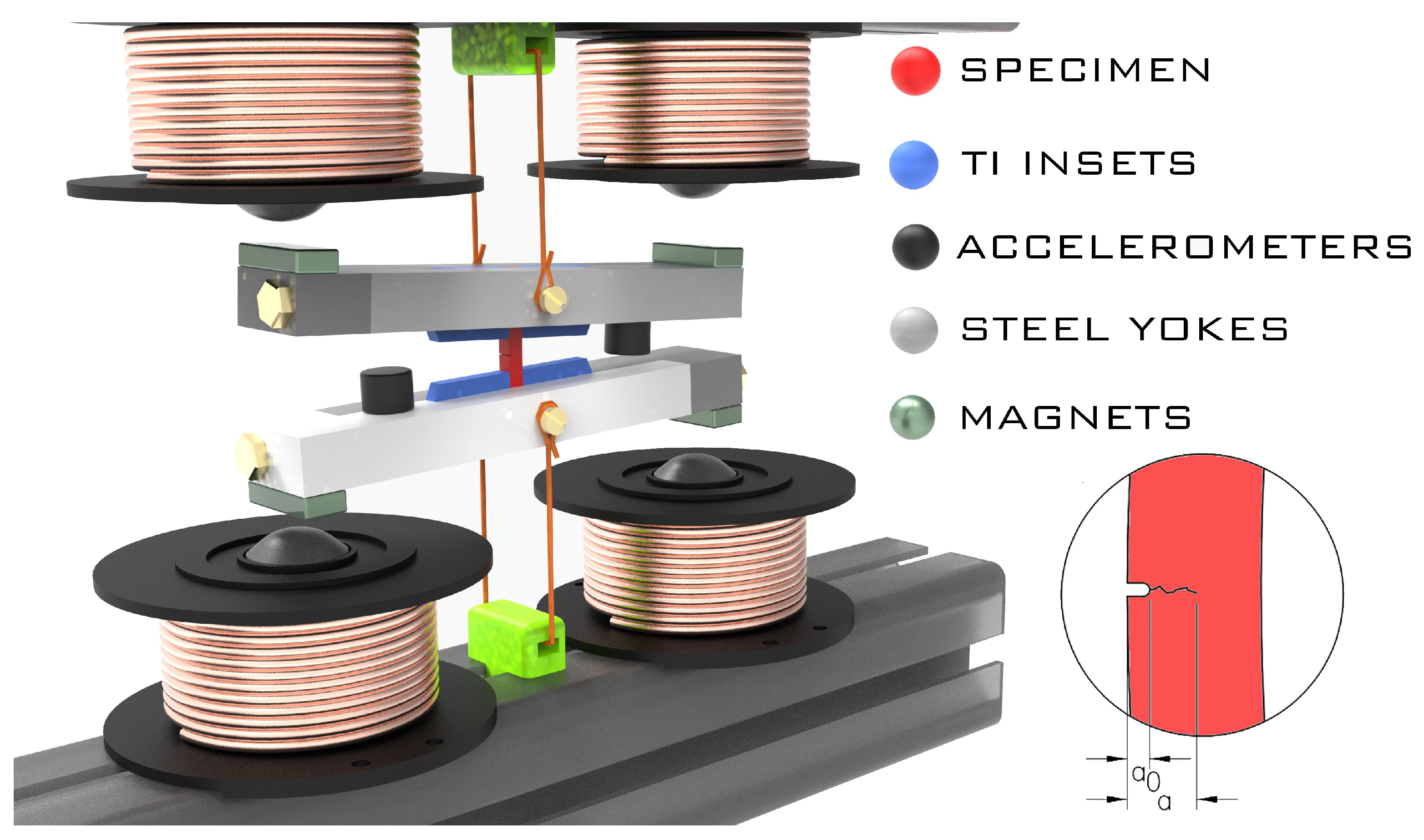

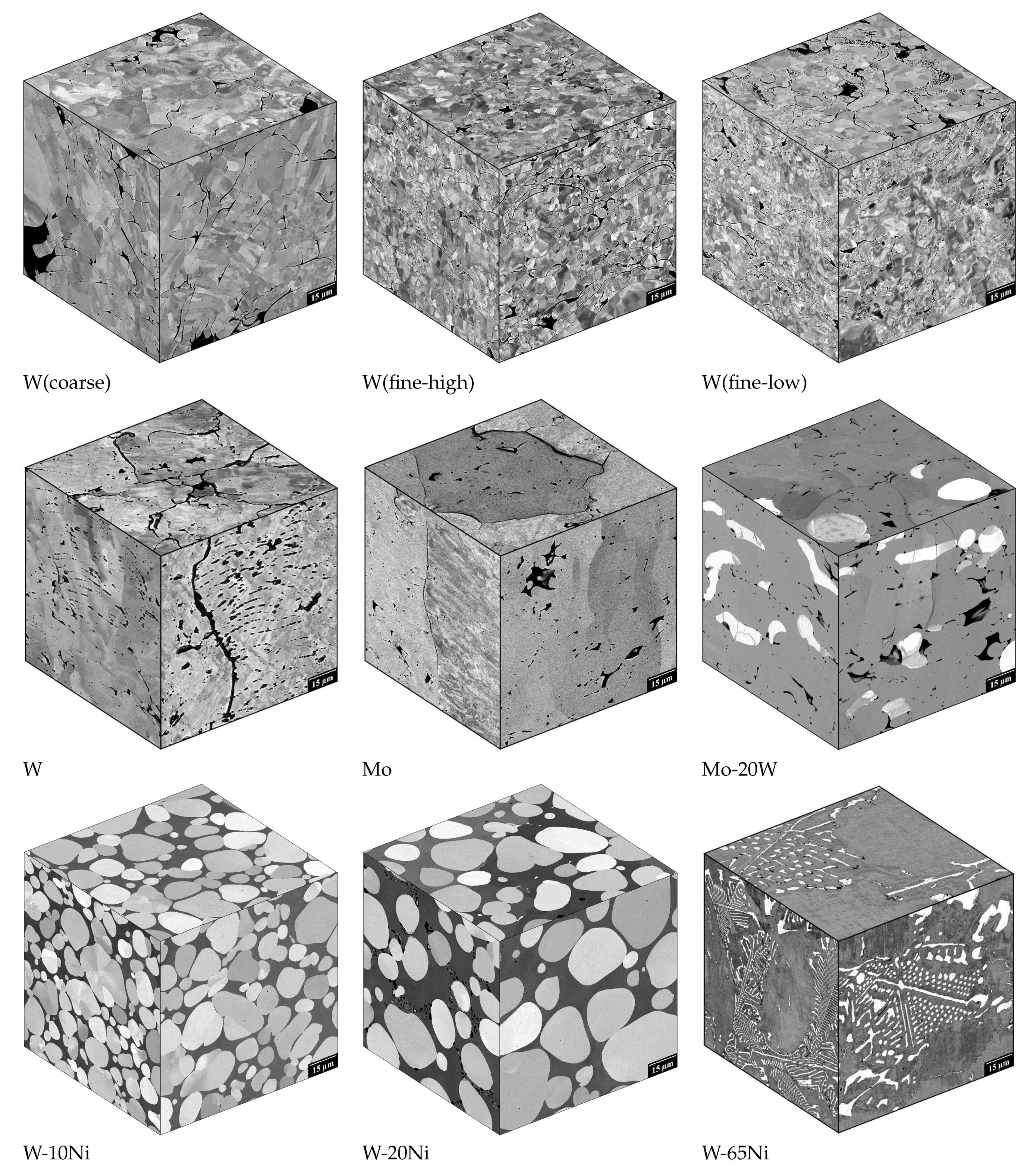
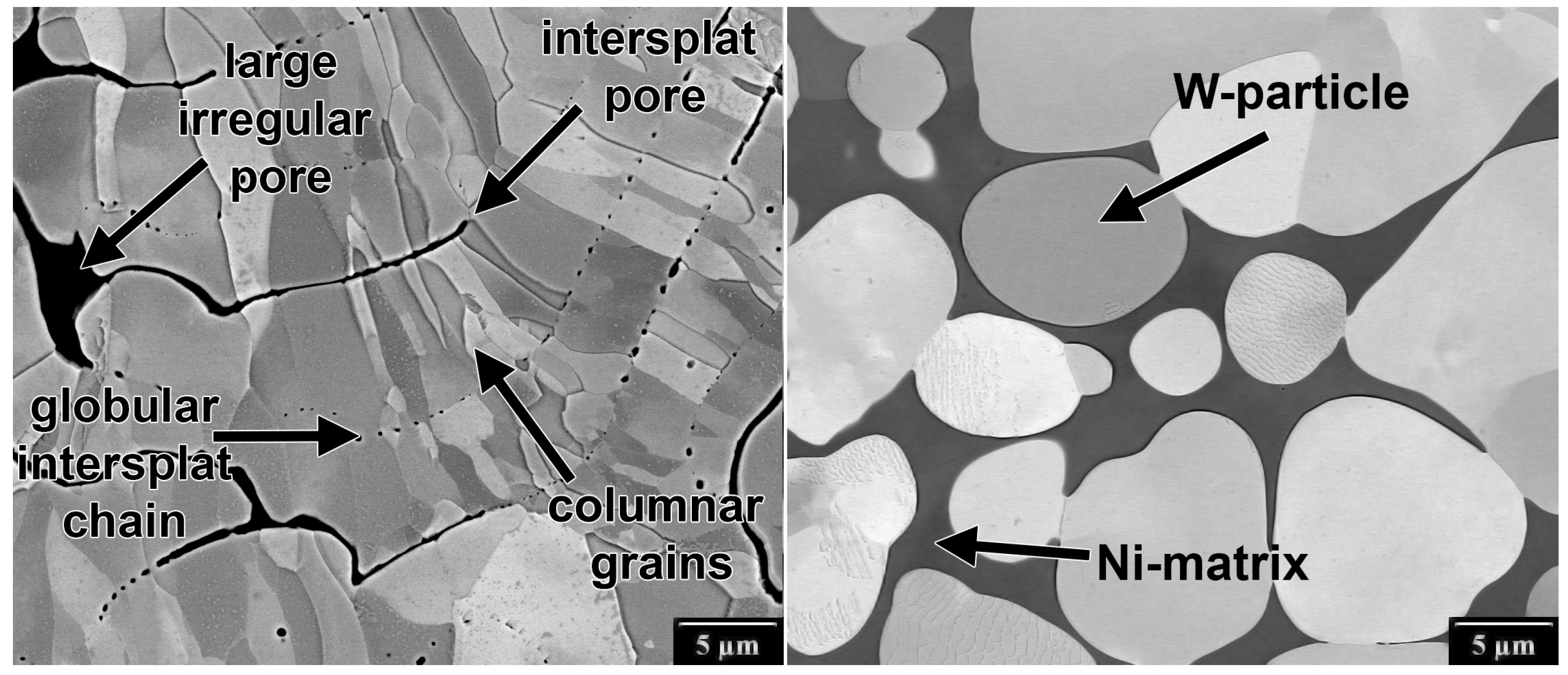
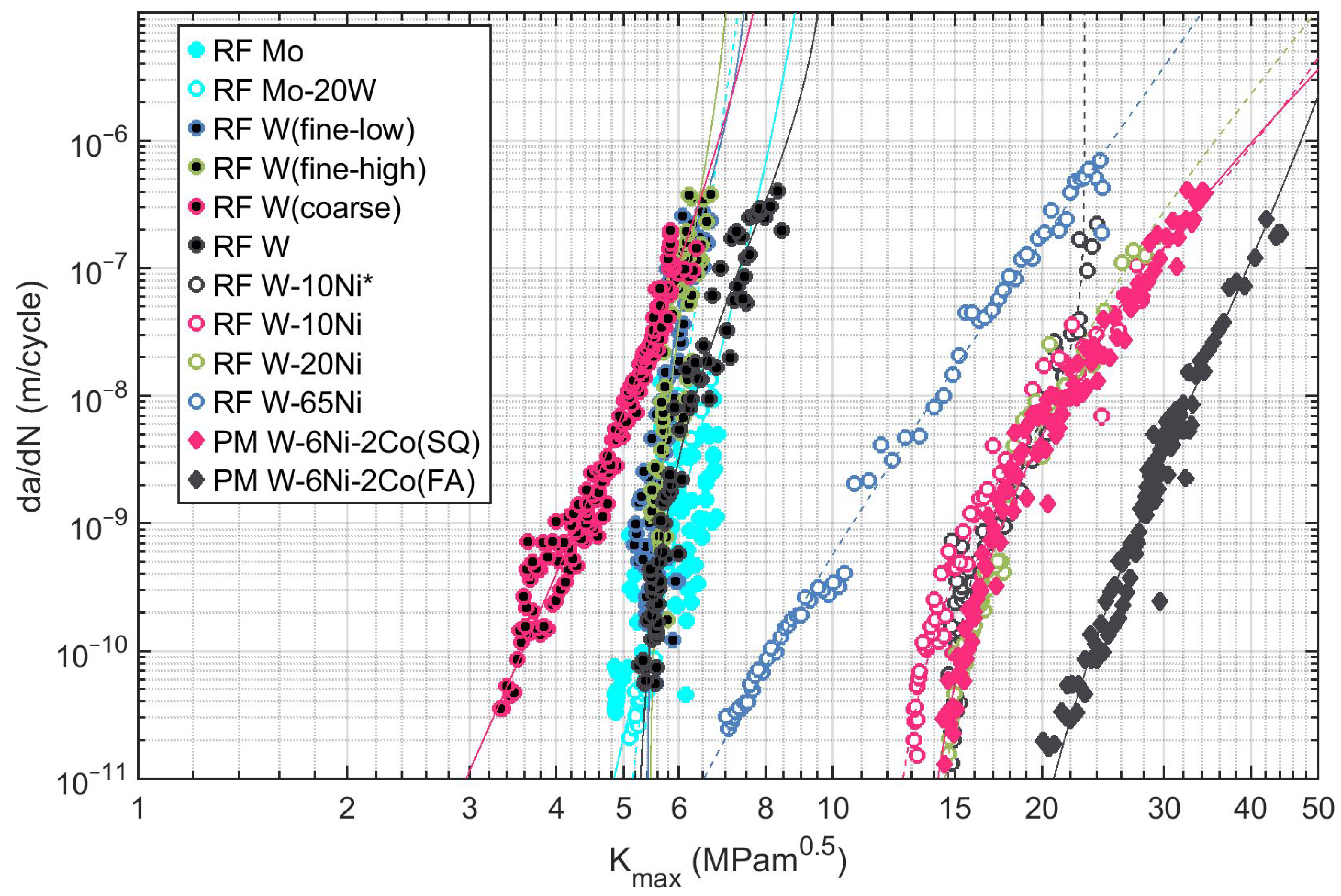
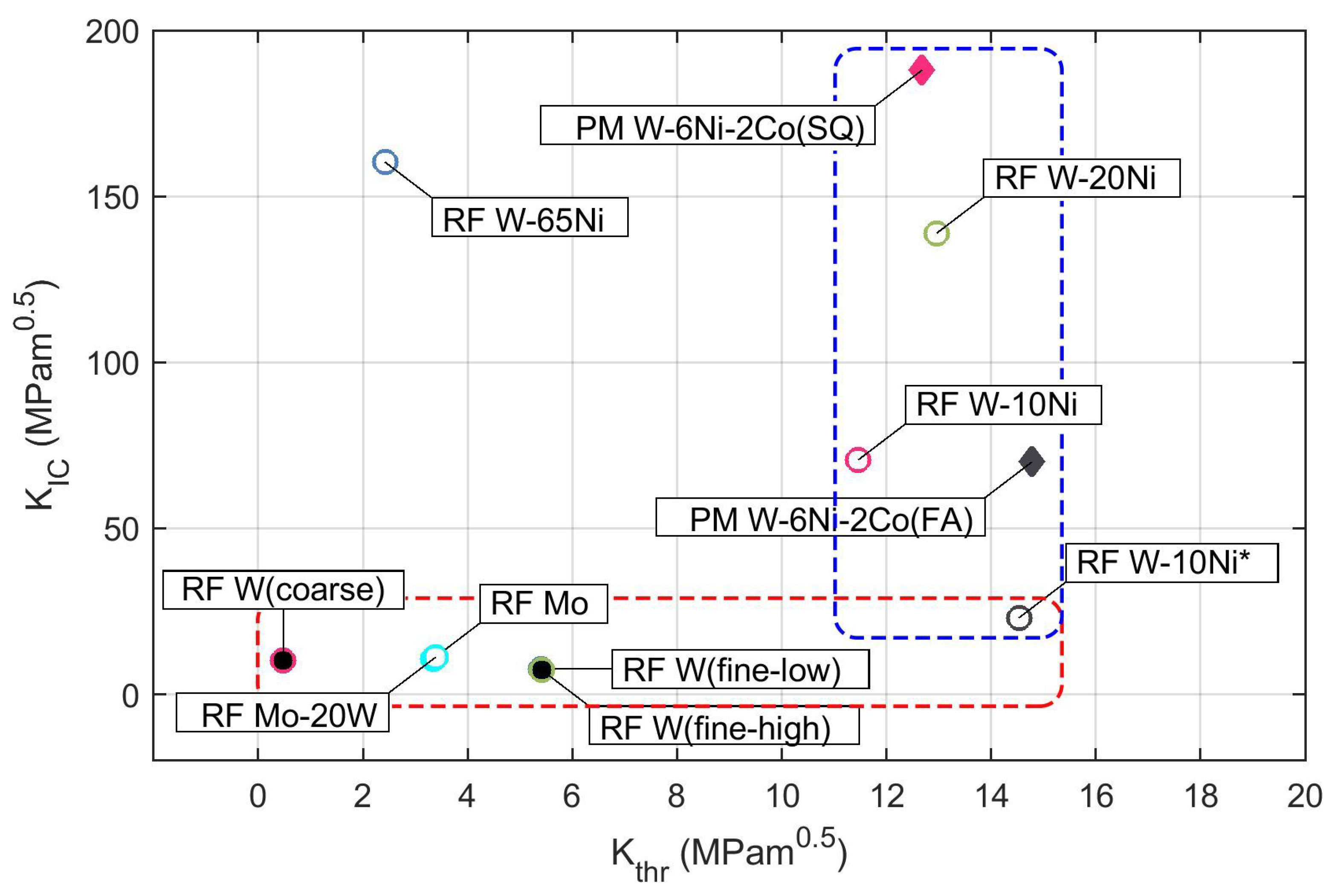
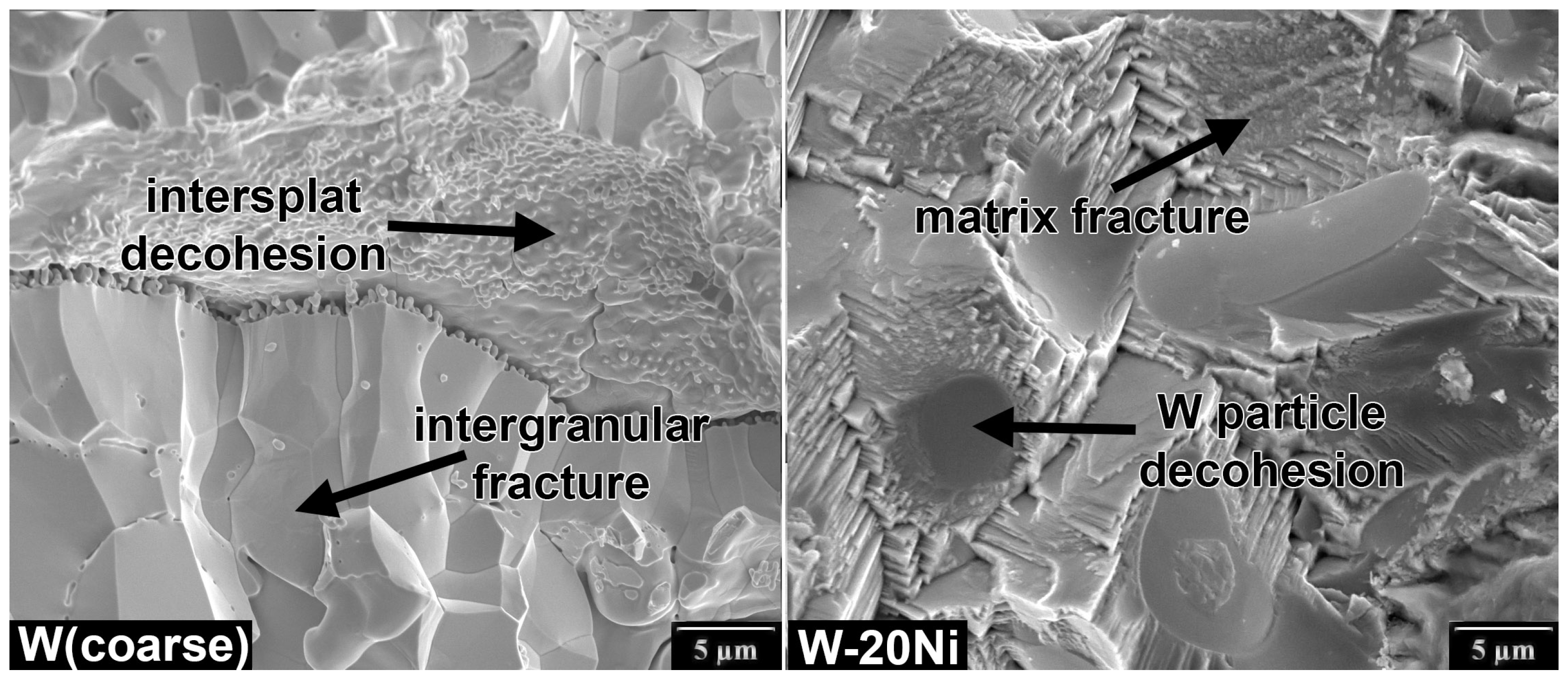
| Powder | Manufacturer | Powder Designation | (µm) | (µm) | Type |
|---|---|---|---|---|---|
| Mo | Tekna | 15 | 45 | spheroidized | |
| W | GTP | MP65S | 10 | 35 | agglomerated-sintered |
| W | Osram | MP75 | 15 | 45 | agglomerated-sintered |
| Ni | H.C. Starck | Amperit 176.068 | 15 | 45 | gas atomized |
| Material | Ref | Powder | Substrate | Scanning Speed (mm/s) | Stand-Off Distance (mm) | Carrier Gas | Carrier Gas (slpm) | Powder Feed Rate (g/min) |
|---|---|---|---|---|---|---|---|---|
| Mo | Mo (pre) | strip | 1 | 90 | Ar | 8 | 12 | |
| Mo-20W | W + Mo (pre) | strip | 1 | 90 | He | 8 | 12 | |
| W (fine-low) | [19] | W | disc | 0.7–1.2 | 70 | He | 8 | 2.3 |
| W (fine-high) | [19] | W | disc | 0.7–1.2 | 70 | He | 8 | 3.7 |
| W (coarse) | [9] | W | disc | 0.9–2.6 | 70 | Ar | 5 | 7.2 |
| W | W (pre) | strip | 1 | 90 | He | 8 | 12 | |
| W-10Ni* | [15] | W + Ni | strip | 1 | 90 | Ar | 8 | 12 |
| W-10Ni | W + Ni (pre) | strip | 1 | 90 | Ar | 8 | 12 | |
| W-20Ni | W + Ni (pre) | strip | 1 | 90 | Ar | 8 | 12 | |
| W-65Ni | W + Ni (pre) | strip | 1 | 90 | Ar | 8 | 12 |
| Material | (MPa·m) | (MPa·m) | (MPa·m) | D | p | (GPa) | (MPa) | (MPa) | |
|---|---|---|---|---|---|---|---|---|---|
| RF Mo | 5.4 | 3.3 | 10.7 | 7.65 | 279 ± 1 | 156 ± 21 | 393 ± 68 | 32.0 ± 4 | |
| RF Mo-20W | 5.4 | 3.4 | 11.2 | 13.58 | 269 ± 9 | n.a. | 100 ± 1 | 0.4 | |
| RF W (fine-low) | 5.5 | 5.4 | 7.7 | 2.41 | 211 ± 12 | n.a. | 290 ± 63 | 1.6 ± 0.2 | |
| RF W (fine-high) | 5.5 | 5.4 | 7.3 | 3.09 | 143 ± 20 | n.a. | 227 ± 33 | 1.6 ± 0.4 | |
| RF W (coarse) | 3.6 | 0.5 | 10.3 | 8.74 | 107 ± 0 | n.a. | 49 ± 7 | 1 ± 0.3 | |
| RF W | 5.4 | 5.2 | 10.0 | 2.97 | 309 | n.a. | 279 | 1.1 | |
| RF W-10Ni* | 15.1 | 14.5 | 23.0 | 1.54 | 342 ± 0 | 728 ± 36 | 751 ± 30 | 2.4 ± 1.5 | |
| RF W-10Ni | 13.8 | 11.5 | 70.6 | 3.24 | 362 | 681 | 1032 | >6.7 | |
| RF W-20Ni | 15.6 | 13.0 | 138.9 | 4.15 | 339 ± 31 | 691 ± 15 | 1102 ± 120 | >6.9 ± 0.3 | |
| RF W-65Ni | 8.3 | 2.4 | 160.3 | 6.47 | 234 | 477 | 630 | >7.1 | |
| PM W-6Ni-3Co (SQ) | 15.4 | 12.7 | 188.0 | 3.84 | 306 ± 3 | 684 ± 2 | 980 ± 9 | >6.0 | |
| PM W-6Ni-3Co (FA) | 23.6 | 14.8 | 70.0 | 5.57 | 321 ± 11 | 1596 ± 31 | 1693 ± 12 | >6.0 |
Disclaimer/Publisher’s Note: The statements, opinions and data contained in all publications are solely those of the individual author(s) and contributor(s) and not of MDPI and/or the editor(s). MDPI and/or the editor(s) disclaim responsibility for any injury to people or property resulting from any ideas, methods, instructions or products referred to in the content. |
© 2023 by the authors. Licensee MDPI, Basel, Switzerland. This article is an open access article distributed under the terms and conditions of the Creative Commons Attribution (CC BY) license (https://creativecommons.org/licenses/by/4.0/).
Share and Cite
Kovarik, O.; Cizek, J.; Klecka, J. Fatigue Crack Growth Rate Description of RF-Plasma-Sprayed Refractory Metals and Alloys. Materials 2023, 16, 1713. https://doi.org/10.3390/ma16041713
Kovarik O, Cizek J, Klecka J. Fatigue Crack Growth Rate Description of RF-Plasma-Sprayed Refractory Metals and Alloys. Materials. 2023; 16(4):1713. https://doi.org/10.3390/ma16041713
Chicago/Turabian StyleKovarik, Ondrej, Jan Cizek, and Jakub Klecka. 2023. "Fatigue Crack Growth Rate Description of RF-Plasma-Sprayed Refractory Metals and Alloys" Materials 16, no. 4: 1713. https://doi.org/10.3390/ma16041713
APA StyleKovarik, O., Cizek, J., & Klecka, J. (2023). Fatigue Crack Growth Rate Description of RF-Plasma-Sprayed Refractory Metals and Alloys. Materials, 16(4), 1713. https://doi.org/10.3390/ma16041713









